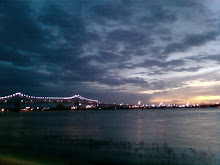The old Miss. River ferry landing at the foot of North Street, located downtown, was the western terminus of US 190 from 1926-35:

River Road crosses the picture, with North Street intersecting. The landing is still used by private shipping. As you can see, this was not a very appealing crossing, with the main Illinois Central (now Canadian National) railroad line traversing the riverfront and passing right in front of the ferry landing.

Not much room between the railroad and the water. Presumably this facility was more developed when passenger autos crossed here. The ferry operated until its closure in 1968....

...when the I-10 bridge opened.

View looking up North Street from the vantage point of the ferry landing. This would have represented the beginning of a trip on US 190 before 1935, and remained part of mainline 190 until 1940, when it was rerouted along the Scenic Highway corridor to use the newly opened Huey P. Long Bridge. The environs of course have changed much since then. The Stalinesque white structures all in a row on the left side of the street, going off in the distance, are state government office buildings which house the growing hordes of state bureaucrats, and were constructed within the last five years in a faux-Art Deco style (to match the landmark Capitol). These buildings' parking needs are served by the similiarly designed state-owned garage structures in the foreground. The lone skyscraper, One American Place, represents the sole glimmer of private enterprise in this precinct.

Street level view of the terminus, the foot of North Street at River Road (the roadway of which did not exist north of this intersection before 1960 or so, BTW). Before 1935 US 190 ended at the rail crossing ahead, with the Father of Waters hidden by the slight berm which is the levee here.
Incidentially, River Road at this location comprises part of Business US 61/190, a modern interpretation of the various through-town US highway routings which existed between 1940-65. So US highways do still serve this vicinity.

In my last post I posited that US 71 ended at the Port Allen ferry landing until 1951. However, this is only one theory, in the absence of more definitive information. From 1940-51 it is possible, and even logical, that US 71 crossed the ferry to end in downtown BR. These next pictures capture potential ends. Main and Third has been suggested; but I cannot believe, from what I know, that it ever served as an end, as no US route ever traversed Main Street to my knowledge.
A better terminus is captured above: North Street at Lafayette Street, one block inland from the river. Here at one time (mid-late 1940s, definitely after 1946), southbound US 61-65 /eastbound US 190 would have entered downtown from the north on N. Third Street (passing the Capitol), made a right at North Street (since Third was one way NB and still is), approached from the upper left of the above image on North Street, then turned left and exited to the upper right on Lafayette. The section of Lafayette St. north of North St. (confused?) was constructed in the mid-1950s and realigned around 2004 - but by this time US highways had been routed away from the vicinity. So to navigate the Lafayette (SB)/3rd (NB) couplet, SB US 61/SB US 65/EB 190 would have had to traverse a one block jog riverward on North (which, BTW, carried two-way traffic back then).

Not much distance between Lafayette Street and the river - one block. This is at ground level facing west. US 71's experience in the Stick would have been humble indeed.

Here is North Street looking east, at the intersection of Third Street (the cross street). The arid environs of the bureaucratic precinct loom large here, and even seen here at rush hour it has an eerily dead quality. To the right entered NB US 61-65/WB US 190 only; to the left entered and exited both directions of US 61/65/190. Traffic following SB 61-65/EB 190 would have turned here from the left and approached the camera's location.
Incidentially, Third Street was the city's "main street" before the age of the strip mall and suburban shopping center, where all the major retail and commercial activity was concentrated. Thus it would have been rather busy, which is why US highways were not routed on Third for very long, outside of a few years in the forties and fifties.

Looking in the other direction, toward the west. We are only two blocks from the river here, and if you squint you can sort of see where it is in the distance. SB US 61-65/EB US 190 would have followed the block of street here to navigate onto the Lafayette/Third couplet. Lafayette Street intersects at the traffic light which you can faintly see in the distance.

Third Street today. This is looking south from North Street, toward the commercial core. The past few decades have not been kind to downtown, and Third Street has lost much of its former vitality. Of course building large institutional structures such as seen here tends to kill off street life, and doesn't help matters much.
In the era when US highways were routed here, the street carried two busy lanes of northbound traffic, with parking. An ill-advised conversion into a pedestrian mall in 1972, along with a renaming of the street to Riverside Mall (all of which was mercifully reversed in 1991) was the major force in making the street more pedestrian friendly. Ironic that pedestrians have better accomodations today, when there is little to no foot traffic outside the lunch hour save for hobos, than in the fifties when things were really hopping here.

Looking the other way on N. Third, former US 61/65/190, north toward the state government campus. The Capitol is within bipping distance of here. Before the mid-1950s this road would have carried two way traffic all the way to the North Street intersection.


